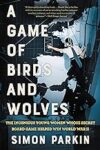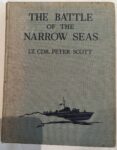
These are books I’ve read, and recommend.
![]() = Affiliate link
= Affiliate link
![]() = I earn nothing!
= I earn nothing!
(And no, that’s not my book shelves above! It’s a rather splendid bookshop called Aardvark Books in a converted barn out in the wilds of Shropshire!)
The Kamikaze Hunters – Will Iredale 
 This is a a part of the Pacific War I knew nothing about. It turns out that once the war in Europe was in its endgame, Churchill was keen to have a hand in the Pacific War. His initial ‘you helped us so we’ll help you’ approach to the Americans was rejected at first, but he persisted and when the Americans were attacking Okinawa, the British Pacific Fleet of six aircraft carriers (Yes! Six! HMS Indefatigable, HMS Indomitable, HMS Implacable, HMS Illustrious, HMS Formidable and HMS Victorious) were hard at work defending the US Navy fleet from kamikazes.
This is a a part of the Pacific War I knew nothing about. It turns out that once the war in Europe was in its endgame, Churchill was keen to have a hand in the Pacific War. His initial ‘you helped us so we’ll help you’ approach to the Americans was rejected at first, but he persisted and when the Americans were attacking Okinawa, the British Pacific Fleet of six aircraft carriers (Yes! Six! HMS Indefatigable, HMS Indomitable, HMS Implacable, HMS Illustrious, HMS Formidable and HMS Victorious) were hard at work defending the US Navy fleet from kamikazes.
The book charts the growth of the Fleet Air Arm and follows the training (mostly in the USA) and experience of Iredale and his fellow pilots, who by the time of the Pacific campaign, had transitioned from Sea Skuas, Sea Hurricanes and Seafires to Grumman Avengers and Chance Vought Corsairs. It’s gripping stuff!
This version, published by Pan, is an abridged version of the original book which I have, published by Macmillan (ISBN 978-1-4472-8471-0). That’s probably to make it work as an audio book.
Hellcat: The F6F in World War II – Barrett Tillman 
 Originally written in 1978, this is a detailed account of the US Navy’s key air superiority fighter in WW2. Until its introduction the Japanese Zero had been on a par with the Hellcat’s robust and worthy predecessor, the Grumman Wildcat. After its introduction in Jan 1943, the Hellcat was dominant. The Zero could still out-turn US Navy pilots at slow speeds, but in nearly all other respects it was out-flown by the Hellcat, which had twice its power and twice its weight.
Originally written in 1978, this is a detailed account of the US Navy’s key air superiority fighter in WW2. Until its introduction the Japanese Zero had been on a par with the Hellcat’s robust and worthy predecessor, the Grumman Wildcat. After its introduction in Jan 1943, the Hellcat was dominant. The Zero could still out-turn US Navy pilots at slow speeds, but in nearly all other respects it was out-flown by the Hellcat, which had twice its power and twice its weight.This book covers all the Hellcat squadrons and their actions in WW2.
The Secret War: Spies, Codes and Guerrillas 1939-1945 – Sir Max Hastings 
 There’s a lot of book here! A huge compendium of secret deeds and ambitions prior to and during the Second World War. Some are tales of brilliance and daring. Many are tales of inept fumbling, mediocrity and failure. At the start of the war only the Russians took espionage seriously, and only they had a practical network of spies and informers in place. The other Allies had to scramble to catch up, and after a weak start in HUMINT, made amazing strides in SIGINT. The Germans on the other hand, well put it this way; Max Hastings is NOT a fan of the Abwehr’s commander, Admiral Canaris!
There’s a lot of book here! A huge compendium of secret deeds and ambitions prior to and during the Second World War. Some are tales of brilliance and daring. Many are tales of inept fumbling, mediocrity and failure. At the start of the war only the Russians took espionage seriously, and only they had a practical network of spies and informers in place. The other Allies had to scramble to catch up, and after a weak start in HUMINT, made amazing strides in SIGINT. The Germans on the other hand, well put it this way; Max Hastings is NOT a fan of the Abwehr’s commander, Admiral Canaris!
By the nature of the subject, this book is full of fascinating stuff you didn’t know, but I think too that Hastings does a really good job of assessing the strengths and weaknesses of the intelligence services, their structures, and their operations.
World War I Battlefields: A Travel Guide to the Western Front: Sites, Museums, Memorials – John Ruler & Emma Thomson 
 This is the slim (104 pages) but excellent (and portable!), Bradt guidebook to the WW1 memorials, sites and museums in France and Belgium. I have the first edition which was published in the build up to the 100th anniversary of the end of the war. This is the updated 2nd edition which now features a number of new museums, tours and projects that also sprang up at the time of the anniversary.
This is the slim (104 pages) but excellent (and portable!), Bradt guidebook to the WW1 memorials, sites and museums in France and Belgium. I have the first edition which was published in the build up to the 100th anniversary of the end of the war. This is the updated 2nd edition which now features a number of new museums, tours and projects that also sprang up at the time of the anniversary.
Declaration of Interest: I know the authors (and the publisher) who are colleagues of mine in the British Guild of Travel Writers.
A Game of Birds and Wolves – Simon Parkin 
 This is an astonishingly good book, about the mostly unknown characters who literally wargamed the tactics needed to eventually win the battle of the Atlantic against the U-boats. It covers the history of the battle in impeccable detail, but always through the eyes of the people who fought it or experienced it. Some of them are major players, many not, and it’s interesting how their stories interweave, highlighting the serendipitous way a team of highly intelligent men & women came together to work out U-Boat tactics and the tactics needed by the escorts to counter them.
This is an astonishingly good book, about the mostly unknown characters who literally wargamed the tactics needed to eventually win the battle of the Atlantic against the U-boats. It covers the history of the battle in impeccable detail, but always through the eyes of the people who fought it or experienced it. Some of them are major players, many not, and it’s interesting how their stories interweave, highlighting the serendipitous way a team of highly intelligent men & women came together to work out U-Boat tactics and the tactics needed by the escorts to counter them.
There are not many WW2 history books that are real “page-turners”, but, even though we know the details of the U-Boat war and how it ended, this is a book you do not want to put down!
The Battle of the Narrow Seas – Lt. Cdr. Peter Scott 
 Most navy historians have this book on their shelves. It’s a classic, describing in detail, and with loads of maps and illustrations, the activities of the Royal Navy coastal forces during WW2. This edition, was first published immediately after the war in 1945/6, in conformity with “Book Production War Economy Standards”, which makes you wonder how well they would have survived if they had been printed to ‘luxury standards’! If you follow the link to Amazon, you may also see more modern editions that I suspect won’t last as long! My 1945 copy is in amazing condition!
Most navy historians have this book on their shelves. It’s a classic, describing in detail, and with loads of maps and illustrations, the activities of the Royal Navy coastal forces during WW2. This edition, was first published immediately after the war in 1945/6, in conformity with “Book Production War Economy Standards”, which makes you wonder how well they would have survived if they had been printed to ‘luxury standards’! If you follow the link to Amazon, you may also see more modern editions that I suspect won’t last as long! My 1945 copy is in amazing condition!
These are the accounts of the Motor Torpedo Boats, Motor Gun Boats and Motor Launches that patrolled the North Sea and English Channel attacking German coastal convoys and fighting off German E-Boats. It covers their operations and the labours of their crews.
I think that one of the things that is interesting is the nature of their work. This was one branch of the forces that operated rather like the RAF. They would leave port on a sortie, usually one night, and then ‘back home for tea’, or not – a very different world to their fellow RN shipmates.

